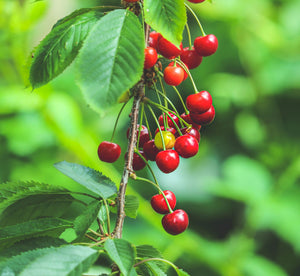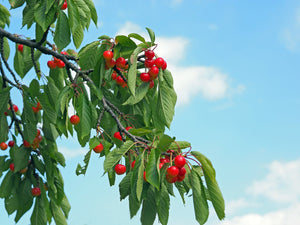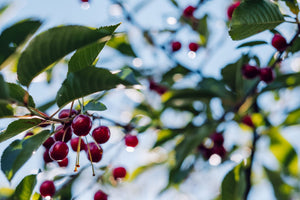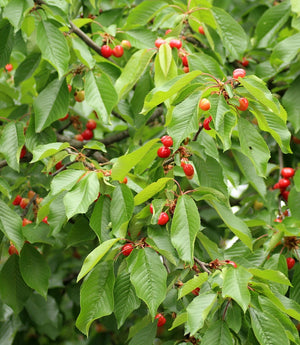The Fruiting Cherry Tree Guide
Fruiting cherry trees offer a bountiful and timeless presence in any landscape. With their graceful stature, lovely blossoms, and delectable fruit, cherry trees draw admiration and provide a touch of natural beauty to gardens and outdoor spaces. These remarkable trees are celebrated for their versatility and can flourish in various conditions when given the proper care and maintenance. Whether you aim to create a fruitful garden haven or desire a prominent centerpiece in your landscape, fruiting cherry trees are an exceptional choice.

About
Fruiting cherry trees belong to the Prunus genus and encompass a variety of deciduous trees celebrated for their delightful presence and ecological significance. With numerous species recognized, fruiting cherry trees flourish in temperate regions across the Northern Hemisphere, including North America, Europe, and Asia. These remarkable trees are distinguished by their unique attributes and essential role in supporting local ecosystems.
One of the distinctive features of fruiting cherry trees is their captivating blossoms, which transform the landscape with vibrant displays of white or pink flowers in the spring. These blossoms are a valuable source of nectar for pollinators, particularly bees, supporting local biodiversity. As the blossoms fade, they give way to small, succulent fruits that come in various flavors and colors, such as sweet cherries or tart cherries.
Fruiting cherry trees are treasured for their ecological importance, providing sustenance and shelter to a wide array of wildlife. Birds, in particular, are drawn to the fruit, while the trees themselves often serve as nesting sites. Additionally, cherries offer a wonderful source of nutrition for both humans and animals.
These versatile trees adapt to diverse soil types and environmental conditions, thriving in well-drained soil, full sun exposure, or partial shade. Their adaptability and moderate growth rate make them an excellent choice for orchards, gardens, and landscaping projects.
Whether used as a vibrant focal point in a garden, planted in rows to establish an orchard, or incorporated into mixed borders, fruiting cherry trees bring an exquisite touch to any landscape. Popular species of fruiting cherry trees include the sweet cherry (Prunus avium) and the tart cherry (Prunus cerasus), each esteemed for their delectable fruit and the ecological diversity they support. By selecting and caring for fruiting cherry trees in your landscape, you enhance the aesthetic appeal of your outdoor space and contribute to the preservation of these remarkable trees and the vibrant ecosystems they nurture.

Planting
Fruiting cherry trees, like all fruit trees, have specific requirements for successful planting and care. Here are some general guidelines for planting and tending to fruiting cherry trees:
Soil: Fruiting cherry trees thrive in well-draining soil that is rich in organic matter. They prefer slightly acidic soil with a pH between 6.0 and 7.0. To prepare the planting site, loosen the soil and incorporate compost or organic matter to enhance drainage and fertility. This provides an optimal foundation for your cherry tree's growth.
Sunlight: Fruiting cherry trees prefer full sun to partial shade. Select a location that receives at least six hours of direct sunlight each day. While they can tolerate some shade, especially in regions with hot and arid climates, they'll produce the best fruit when given adequate sunlight.
Watering: Adequate watering is essential for the initial establishment of fruiting cherry trees. After planting, water the tree deeply, and maintain regular irrigation throughout the first year. Ensure deep and thorough watering once or twice a week, depending on local rainfall and soil moisture levels. Be cautious not to overwater, as excessive moisture can lead to root issues and rot.
Mulching: Apply a layer of organic mulch around the base of your cherry tree to conserve moisture, inhibit weed growth, and regulate soil temperature. You can use wood chips, bark, or compost as mulch. Ensure it's a few inches away from the tree's trunk to prevent moisture accumulation that could harm the tree.
Pruning: Fruiting cherry trees typically require some pruning to maintain their shape and health. You may need to remove dead, damaged, or crossing branches, ensuring the tree maintains a strong and balanced structure. Pruning is best done during late winter or early spring while the tree is dormant, before new growth appears.
By adhering to these fundamental planting and care practices, you can promote the successful establishment and robust growth of your fruiting cherry trees. This will enable them to thrive and grace your landscape with bountiful and delicious cherries for years to come.

Care
Fruiting cherry trees, just like beech trees, require specific care to ensure their optimal growth and fruit production. Here are some general guidelines for the care of fruiting cherry trees:
Watering: During the growing season, provide consistent and moderate watering to your fruiting cherry trees. Aim for about one inch of water per week, but adjust this based on local rainfall and weather conditions. To encourage deep root growth, it's important to water deeply and thoroughly. Avoid shallow watering, which can lead to stress and dehydration. During periods of drought or high temperatures, be prepared to increase your watering frequency to maintain adequate soil moisture.
Pruning: Fruit cherry trees typically require some pruning to ensure their health and productivity. While they don't need extensive pruning, it's advisable to remove dead or damaged branches to maintain the tree's overall well-being and appearance. You can also shape the tree to achieve your desired size and form. The best time for pruning is during late winter or early spring before new growth emerges. Always use clean and sharp pruning tools to minimize the risk of harming the tree. Deadheading spent flowers can also encourage new growth and potentially lead to a second flowering.
Fertilizing: Proper fertilization can promote healthy growth and abundant fruiting in cherry trees. Apply a balanced, slow-release fertilizer in the spring or early summer, following the manufacturer's recommended application rates and timing. It's crucial not to over-fertilize, as excessive fertilizer can harm the tree's roots. If you're unsure, it's better to use less fertilizer than to overdo it.
Soil and Sunlight: Fruiting cherry trees thrive in well-draining soil and prefer full sun exposure. While they can tolerate various soil types, ensuring your soil drains well is essential for their optimal growth. Applying mulch around the tree's base helps retain moisture and regulates soil temperature, further supporting the tree's health.
Pests and Diseases: While cherry trees are generally hardy, they are susceptible to specific pests and diseases, such as aphids and various fungal issues. Regularly inspect your tree for signs of damage or disease. If you observe any problems, address them promptly with appropriate treatments, which may include insecticides or fungicides.
By following these fundamental care guidelines, your fruiting cherry trees will flourish, offering you not only their beauty and shade but also a bountiful harvest of delicious cherries in your garden for years to come.

How To Use
Fruiting cherry trees, much like beech trees, offer versatility and can be utilized in various ways to enhance your landscape. Here are some recommendations based on their characteristics:
Focal Point: Fruiting cherry trees can be an enchanting focal point in your landscape. Plant a single cherry tree in an open area to showcase its beautiful blossoms in spring and abundant fruit in summer. This not only adds aesthetic charm but also provides a lovely fruit harvest.
Shade Tree: With their broad and lush canopy, cherry trees offer excellent shade. Strategically plant them near outdoor seating areas, patios, or decks to create a shaded retreat where you can relax and enjoy the outdoors during the hot summer months.
Windbreak: Cherry trees can serve as a natural windbreak with their dense foliage. Placing them in a row can shield your garden or home from strong winds, creating a protective barrier while providing the benefit of fresh, homegrown fruit.
Privacy Screen: Use the dense foliage of cherry trees to establish a natural privacy screen in your landscape. Plant them in a row along your property line to create an attractive and functional barrier that enhances both privacy and aesthetics. Enjoy not only your personal space but also the fruit they yield.
Wildlife Habitat: Fruiting cherry trees contribute to the biodiversity of your garden by attracting various wildlife species, especially during the fruiting season. Birds and small mammals are drawn to the delicious cherries. Create a welcoming habitat by planting cherry trees and enjoy the sight and sounds of wildlife thriving in your outdoor space.
When selecting fruiting cherry trees for your landscape, consider their specific variety, growth rate, and environmental requirements. Ensure they are planted in areas that receive adequate sunlight and provide well-drained soil with proper pH levels. With their blossoms, delicious fruit, and functional benefits, cherry trees are an exceptional addition that will enhance both the beauty and functionality of your outdoor environment.
Conclusion
Fruiting cherry trees are a captivating and versatile addition to any landscape. Their enchanting blossoms, bountiful fruit, and ecological significance make them a sought-after choice for various settings. By adhering to proper planting and care practices, you can relish the beauty and benefits of fruiting cherry trees in numerous ways, whether it's creating a picturesque orchard or providing a source of fresh, homegrown fruit. Whether you choose to showcase their springtime splendor as a focal point or incorporate them into a larger garden design, fruiting cherry trees offer endless possibilities to enhance the allure of your outdoor space. With dedication and care, you can cultivate a delightful landscape that will reward you with luscious cherries and lasting joy for years to come.
